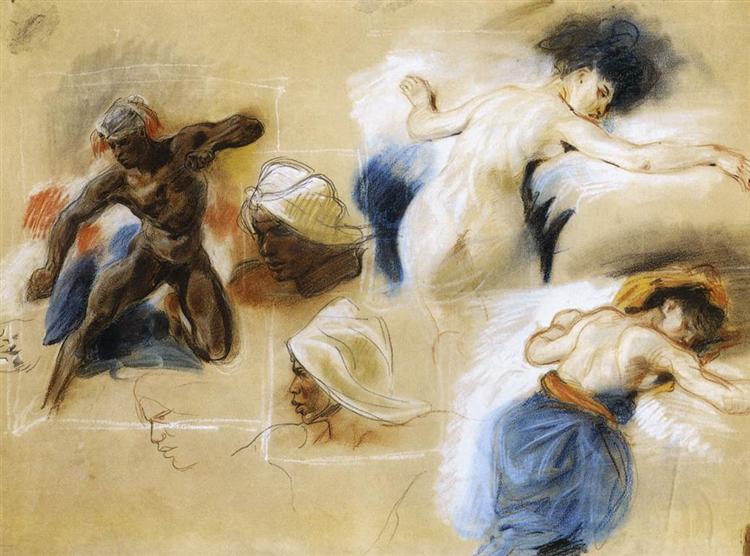Descriere
Pictura „Sardanapalo Boopo” de Eugène Delacroix, realizată în 1827, este o lucrare care încapsulează intensitatea emoțională vibrantă și măiestria tehnică îndrăzneață pentru care este recunoscut artistul. Această schiță este precursorul celebrului tablou cu același nume pe care Delacroix l -ar completa ani mai târziu, în 1827. Captând drama unui moment crucial, schița ilustrează moartea legendarului rege asirian Sardanápalo, o poveste pe care Delacroix a luat -o de la un Lucrarea unei opere a Domnului Byron, care a reinterpretat figura istorică ca simbol al disperării și al luxului, imortalizat în cultura romantică.
Din punct de vedere compozițional, lucrarea este o explozie de dinamism și conflict. Prima impresie pe care o ia spectatorul este dispoziția riscantă a figurilor care par să se deplaseze într -un vârtej de emoție. Delacroix folosește linii diagonale care ghidează privirea observatorului prin lucrare, îndreptându -l spre figura centrală a regelui, care se află în centrul pânzei, înconjurat de un haos vizual care reflectă decizia lui de a opta pentru o moarte tragică în loc de captare. Violența actului este însoțită de o desfășurare de figuri care se răsucesc și agitat, o manifestare pe care Delacroix a gestionat -o cu măiestrie, sugerând o tulburare emoțională.
Utilizarea culorii în această schiță este remarcabilă. Delacroix, maestru de culoare, folosește o paletă bogată și vibrantă care consolidează tensiunea scenei. Roșii intense și un galben strălucitor contrast dramatic cu umbre adânci, creând o atmosferă de rezultat iminent. Această utilizare a culorii nu numai că exprimă violența acțiunii, dar oferă și o aprofundare psihologică emoțiilor personajelor înfățișate. Tonurile calde evocă atât focul, cât și pasiunea, elemente care sunt puternic asociate cu figura lui Sardanápalo.
În ceea ce privește personajele, Delacroix îi reprezintă într -o stare de agitație, reflectând disperarea unui imperiu pe cale să cadă și drama umană a alegerii personale. În stânga, figura unei femei, a cărei expresie și postură sugerată pare să combine teroarea și disperarea, poate fi interpretată ca un simbol al celor care sunt destinați să împărtășească fatalitatea regelui. Prezența lui consolidează dualitatea iubirii și a morții care pătrunde în pictură. Cu toate acestea, nu toți indivizii sunt clar delimitați, ceea ce implică probabil estomparea granițelor dintre haosul personal al Sardanapalo și suferința regatului lor existențial în acest caz.
Schița, deși preliminară, este o lucrare completă de artă în sine, care permite aprecierea procesului creativ al Delacroix. Acesta evidențiază capacitatea sa de a surprinde nu numai forma și culoarea, ci și sensul mișcării, emoției și narațiunii, transformându -și schița într -un spațiu contemplativ despre condiția umană, lupta și destinul. Această lucrare anticipează și stabilește multe dintre caracteristicile care ar fi văzute în lucrarea sa cea mai matură și în manifestarea romantismului, o mișcare care a respins normele neoclasicismului și a îmbrățișat individualitatea, subiectivitatea și abordarea emoțională.
Pe scurt, „Sardanapalo Death Sketch” nu este doar un pas preliminar către o capodoperă mai recunoscută, dar este, de asemenea, o mărturie a stilului inovator al lui Eugène Delacroix, care, cu îndrăzneală și fertilitate creativă, continuă să rezoneze în arta contemporană contemporană . Complexitatea vizuală și emoțională a acestei piese stabilește un dialog constant între privitor și artist, invitând o reflecție asupra disperarii și a luptei iminente care rezonează de -a lungul secolelor, menținându -și relevanța în studiul artei și istoriei.
KUADROS ©, o vopsea faimoasă pe peretele tău.
Picturi de ulei realizate manual, cu calitatea artiștilor profesioniști și sigiliul distinctiv al KUADROS ©.
Imagini Serviciu de reproducere cu garanție de satisfacție. Dacă nu sunteți complet mulțumit de replica tabloului dvs., vă rambursăm banii 100%.

